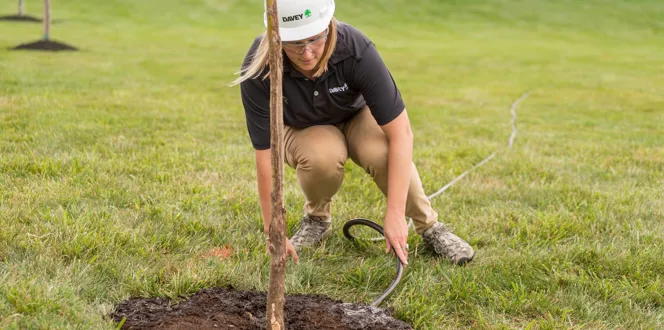Did you know more than 50 percent of most living trees' weight is water? That H2O helps trees thrive.
Just like you, water keeps trees hydrated and functioning. Trees need water to grow new leaves and roots, photosynthesize, transport nutrients, and even fight off pests and diseases.
All these awesome perks may have you ready to run outside and fire up the hose. But, keep reading! You want to water your tree deeply, which you can do easily with one of these tree watering systems.
Why Make A Homemade Tree Watering System?
Think about a time you’ve stood over your tree with a hose, wondering if you sprinkled too much or not enough. Meanwhile, the water is bubbling up near the trunk or spilling out onto the lawn. This method barely replenishes tree roots past the surface and wastes a ton of water.
Deep watering is much more effective at reaching tree roots. When water soaks down into the tree’s soil, it goes to all the roots, not just the ones you can see.
With a watering system, you can deliver just the right amount of water to your tree’s roots in a snap.
How To Water Young Trees With A 5-Gallon Bucket
For this DIY trick, you’ll need a 5-gallon bucket and something to puncture the bucket, like a drill or hammer and nail.
- On the bottom of the bucket, make two 1/16th-inch holes near the outer edges on opposite sides. The goal is to have more than one hole that is each about a pencil diameter in size so the water seeps out of the bucket slowly.
- Place the bucket on the tree’s drip line, the area directly under the canopy’s furthest reach.
- Fill the bucket with water all the way to the top. Wait for the water to drain slowly into the tree’s soil.
- When the bucket is empty, move it halfway around the tree and repeat the process. If you want, you can use two buckets on either side of the tree to save time.
- And there you have it! Repeat the steps two to three times per week so your tree is receiving 10 to 15 gallons of water in total.
How To Make A DIY Tree Watering Bag
For this method, you’ll need a 20-to-30-gallon garbage bag, one female and one male quick-connect adapter, and a 2-to-4-foot piece of hose.
- Cut a hole in one of the trash bag’s corners, small enough for the female quick-connect to fit tightly without gaps. The side that connects to the main hose should be on the outside of the bag.
- Cut a 2-to-4-foot piece off of an old hose, or, buy a short hose that’s this size, to put inside the bag.
- Attach the short piece of hose to the male quick-connect inside the bag. Then screw the male and female connectors together.
- Tightly knot the end of the garbage bag. Connect your main hose to the female quick-connect outside of the bag and fill the bag. Make sure it doesn’t get too full or it may burst.
- Poke a few small holes in the bottom of the bag with a needle.
- Wait for the water to empty, and voila! Repeat the full process every week in summer or during drought periods.







